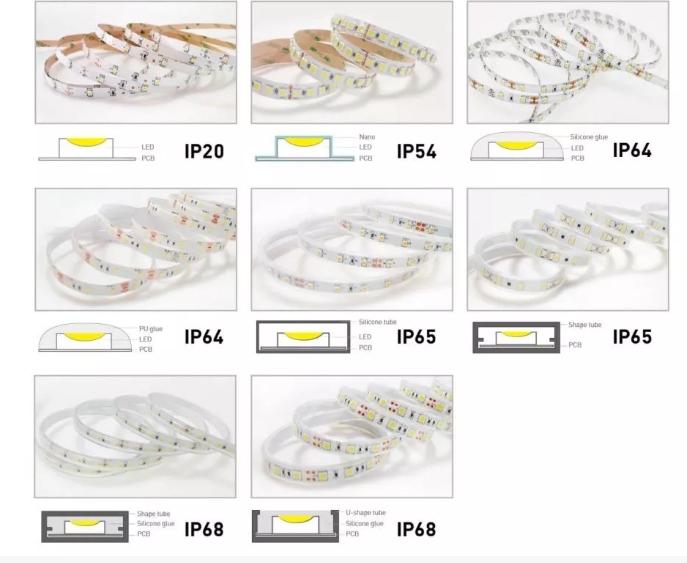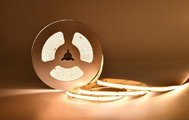How to choose the waterproof IP level of LED light strips?
LED light strips are popular because they are energy efficient, environmentally friendly, and versatile. However, I love their versatility. LED light strips can be used in different weather environments based on their IP rating, so I use them for a variety of DIY projects.
If you want to buy a waterproof LED light strip, first check its IP rating. Depending on where you want to install the light strip, choose an IP rating. Common light strip IP ratings are: IP20, IP33, IP44, IP65, IP67 and IP68.
Choosing an IP rating is easy. The harsher and dustier the environment, the more IP protection you need. Typically, low IP rating strips are suitable for indoor use. If you want a waterproof LED light strip, choose one with an IP65, IP67, or IP68 rating. Choose the level of protection based on the conditions under which you want to install the LED strip.
In this article, you will learn about the different waterproof IP ratings. It will help you figure out which waterproof LED light strip is right for you. But, before that, let us find out what an IP rating is.

What is an IP rating?
IP, or intrusion protection code, measures a device's resistance to solid and liquid materials. There are two numbers in an IP rating.
The first numbers 0 to 6 relate to defense against solid objects such as dirt, dust, and sand. The second number 0 to 8 indicates moisture or liquid resistance.
For example, in the IP 65 rating, the number 6 indicates dust resistance, while the number 5 indicates water resistance. So when you choose an LED strip manufacturer, check these ratings.
Different Types of Waterproof IP Ratings for LED Light Strips
Today, LED light strips come in a variety of waterproof IP ratings. You can choose it based on where you want to install the strip. Information about IP ratings is often provided along with other details about the product.
Here are the different IP ratings of LED light strips and their ability to withstand liquids and dust. It will give you an idea of which IP-rated LED light strip is suitable for your needs.
IP20 protection level
The IP20 rating represents the basic level of protection of the LED light strip. The IP20-rated light strip is touch-proof and resistant to objects over 12mm in size.
Nonetheless, these LED light strips are not waterproof. These light strips should not be used in the open air or where they will be exposed to water spray. You can install these light strips for backlighting in indoor venues.
IP33 protection level
For some LED light manufacturers, this is a standard rating. The IP 33 LED light strip protects against water spray at an angle of 60 degrees and solid objects larger than 2.5 mm. This kind of LED light strip is generally suitable for indoor use.
IP44 protection level
If your LED light strip has an IP44 rating, it can withstand directional water splashes. In addition, solid objects larger than 1mm will not damage this type of lamp. Therefore, these lights are suitable for a variety of indoor and outdoor environments.
IP65 protection level
LED light strips with an IP65 rating are waterproof. If you buy an LED light strip like this, you don’t have to worry about water jets coming from any angle.
Additionally, the strip is dustproof, meaning dust particles cannot get inside the diode or affect its performance in any way.
However, keep in mind that this rating does not make your strip completely waterproof.
You can stick this type of light in wet areas such as bathrooms, decks, stairs, patios, and similar outdoor locations.

IP67 protection level
You could call an IP67 waterproof LED strip a plus. This LED works normally even after being immersed in water for ten minutes. If I talk about their ability to support solid objects, they do not let dust in.
Both IP65-rated LED light strips and IP67-rated LED light strips use similar coating materials. However, they have additional glue seals on each end to make them more weather resistant. These LED lights can easily withstand rain. You can use it outdoors for both commercial and domestic purposes.
IP68 protection level
With an IP68 rating, the LED light strip is also dustproof. What makes them unique is that you can use them permanently in water up to three meters deep.
Since these LED lights can be submerged underwater up to three meters, you can use them to decorate your aquariums and swimming pools.
What waterproof IP rating should I choose?
Now you know what LED strips with different IP ratings can do. So now you can choose them as per your requirements and budget. LEDs with higher IP ratings will cost more.
So my advice is, if you want LED strips for indoor and protected areas, go for a low IP rating.
If the location where you want to install the LED strip is filled with debris and may come into contact with liquids, choose a higher IP rating.
When should I use IP65 rated LED light strips?
You don’t need to think about waterproofing in your LED strips before using them outdoors. Non-waterproof LEDs are perfect for living rooms, bedrooms or behind cupboards. These LED light strips are also cost-effective.
If you want to enhance the ambience of your kitchen, bathroom, or similar places where water splashes are likely to occur, choose IP65-rated strips. In most outdoor scenarios, an IP 65 rated LED light strip will serve your purpose.
When should IP67 and IP 68 rated LED light strips be used?
As I discussed in the section above, these LED light strips can survive in water. You can use them in rain and dust. The IP 68 rated LED can operate underwater up to 3 meters. However, my advice is not to choose these light strips until you want to soak them in water.
You can use IP68 rated light strips to beautify your swimming pool, fish tank or submerged place.





